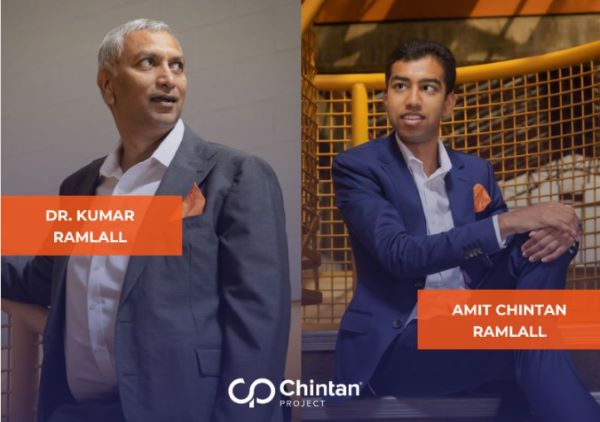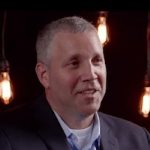Purpose-Driven Leadership: Cultivating Inclusion & Opportunity For Organizational Brilliance With Dr. Kumar Ramlall And Amit Ramlall
This episode brings you an insightful conversation on purpose-driven leadership, featuring exceptional thinkers Dr. Kumar Ramlall and Amit Ramlall, co-founders of the Chintan Project. Navigating their own unique journeys, Dr. Ramlall and Amit show how challenges become opportunities especially when aligned with purpose. Together, they discuss the transformative power of purpose-driven leadership in shaping a positive and opportunistic environment for all team members. The episode also tackles the importance of recognizing individual strengths and authentic gifts, with Amit and Dr. Ramlall highlighting the value of helping employees see the intrinsic worth they bring to the organization. What is more, they explore the role of leaders in creating a culture that fosters the recognition and utilization of diverse talents, ultimately leading to a more productive and thriving workforce. Tune in for a dialogue that promises to reshape your leadership landscape.
—
Purpose-Driven Leadership: Cultivating Inclusion & Opportunity For Organizational Brilliance With Dr. Kumar Ramlall And Amit Ramlall
Welcome, everyone, to the show. We’re a show that guides leaders to elevate the workplace. We believe that people are not only the heart of successful organizations, but they are the critical component that’s going to drive success going forward. Team members’ well-being rewards their career development. It’s all essential to a happy, healthy, and highly productive workforce.
This show discusses the practical and effective leadership strategies for top executives, senior professionals, and talent managers overall. We have a conversation around purpose-driven leadership in a very unique way. It’s a way to ensure that leaders have a way to increase their opportunistic environment for all of their people. We’re going to be going through that with our two speakers.
Joining us are two exceptional thinkers. We have Amit, and then we also have Kumar, Cofounders of the Chintan Project. Amit has a unique journey through his autism maze. He has become an inspiring polymath, a beacon for those seeking to fuel purpose amidst the life challenges that they’re facing. His appetite for knowledge, understanding, and human behavior in his drive towards personal achievement puts him in a unique position for leadership development across the world.
Alongside him, Dr. Kumar Ramlall brings his profound medical experience and his personal experience as a parent and entrepreneur. His deep understanding of human potential has been a cornerstone in helping individuals and businesses not just succeed, but also thrive. Together, they embody a philosophy that challenges become opportunities when aligned with our purpose. Let’s get ready to dive into the dialogue that promises to reshape your leadership landscape.
‐‐‐
Welcome, Kumar and Amit to the show.
Sam, thank you very much for having us. I am Kumar.
I’m Amit.
Amit has a leftover of having had autism, Sam, which is a slightly unique way of conversing. What happens is that he uses a card. For those of you reading, it’s an alphabet card. We jokingly say it’s a $0.50 piece of plastic that has grown a global consulting company. It’s the letters of the alphabet on cardboard. It’s laminated. Amit types in that and I read what he’s saying.
Amit says , “Sam, thank you so much for having us on with you For your audience. I use this card to help me speak much as some use glasses to help them here or help them see. I tap on this card and my dad reads what I am tapping. When he speaks for me, he sounds like a robot. When he speaks for himself, he sounds at least half human.”
I can understand how that is. I imagine my children would say the same. It’s such a blessing to work with family. For one, I enjoy it myself. I know it can be a very powerful advantage in really delivering the best of what we have to offer to people.
Amit says, “Sam, there is no pleasure without pain. They come hand in hand. We have come to know that working as closely as we do with family has challenges and opportunities. Many businesses are family-owned or family-controlled. It is quite striking. I dare say that even when businesses don’t acknowledge that they are family-controlled, many CEOs will only secretly admit who’s their boss.”
Amit’s Journey With Autism
Amit, I would love to dive deeper into your story because I know that your experience, your struggles, and your journey through your life have created something very unique. It created something that can really change the mindset of leaders to guide them to recognize the important potential in all of their people. Can you tell us a little bit about how your journey with autism has shaped your perspective on leadership and understanding the human potential overall?
Amit says, “Absolutely. I had challenges and severe medical problems even before I was born. I had intense physical pain that kept me from moving much. In the midst of this pain, I got some clarity or somehow, I came to know why I have this. In some ways, while I perhaps never got the answer of what that reason was, I had a certainty that there was a reason why I came to believe and later know that this universe of ours exists on purpose. Everything is purposed. Sam, if everything is purposed, it must mean that our challenges are purposed too.”
This universe of ours exists on purpose. Everything is purposed. If everything is purposed, it must mean that our challenges are purposed to. Share on XAgreed.
Amit says, “I spoke with a business owner who had cancer. Speaking with her, she talked about ridding herself of the disease, chopping it out, and tossing it away from her. All names are changed to protect the innocent here. I said, “This is interesting, Claire, that you speak of tossing your cancer out, ripping it from you. I don’t have that option for if I ripped autism from me, I wouldn’t even know who I am in some ways.
More importantly, I would be robbing myself and the rippled world I help with the gifts that autism has brought me. Navigating this maze that was autism, which I felt called to do for myself, has given me a deep, profound understanding of how we humans tick and how we relate.” What is this thing that moves the needle for human awareness and human achievement? That’s how I got into human behavior advisory and consulting.”
I love that.
Amit says, “My challenges became part of my reason why, didn’t it?”
Transforming Challenges To Opportunities
Yes. I can see that. One thing that I’d like to dive into a little bit more is that you mentioned that your client has cancer. That’s a terminal illness that makes you focus on the time that you have and be most impactful for the time that you have. I would challenge that autism, ADD, and many of those other types of cognitive differences in how people approach themselves and how they solve solutions is something a little bit different. All of us have certain things that we have to live with and live through. If we’re intelligent and like you, Amit, we find strength in some of those things that we need to deal with.
That’s why I find both of you so inspiring as a team. You have taken something that many people think is a weakness, something that they don’t quite understand, and have turned it into a superpower. It is a way to broaden the horizons of leadership to understand the true potential of not only people with autism but people with other types of cognitive approaches in which they think differently and how it can enhance the workforce. Have you had success in changing the mindset of people that you work with to understand that opportunity?
Amit says, “It’s interesting because there was a significant push from the marketplace that I leveraged my challenges to be an expert in inclusion and diversity. In a strange way, I have avoided that. I carefully and meticulously avoided that. In fact, I once, when I was being interviewed for a magazine cover story, horrified the editor when I said the following, “If I ever got a job because of a checkbox, I would be horrified. I would be disgusted with myself.” I know, Sam, that is not politically correct for the world, but it was for me. I would argue that hidden in that statement is an important message not only for leaders but for every worker and every employee.”
I love your passion, Amit.
Amit says, “Here is what I am talking about. Every single one of us has a purpose that is unique to us. Our universe, this universe of ours, is so efficient that there are no duplicates. I know that when we follow this thing called purpose or we live true to who we authentically are, no one can out-compete us. We get out-competed when we line up against others.

Purpose-Driven Leadership: Every single one of us has a purpose that is unique to us. This universe of ours is so efficient that there are no duplicates. When we follow this thing called purpose and live true to who we authentically are, no one can outcompete us.
That is a message for leaders to help find the gold nugget within the ton of dirt as Andrew Carnegie talked about. It helps you or the employee to start making an audit of their authentic gifts because, to the extent that they are able to help those shine, if their current employer doesn’t see the value, someone else will. Your job is to raise your worth. Your net worth, Sam, is part of a simple equation. Net worth equals self-worth plus others’ worth. You have control over those two parameters. Some of the increase occurs in both of those parameters. Some of the increase occurs by recognizing what you bring to the table.
I’m going to be meeting with staff at one of the companies that we control. We’ll be saying to them, “What you get paid is a matter of the value that you bring to the organization. It’s not a pay scale. It’s what value are you bringing to the organization. Let’s sit here and plan out how you can bring more value to the organization.” As we do that, we will be helping them to leverage their authentic gifts.” Does that make sense?
It does.
Amit says, “I’m working with them to pay them more. The evaluation will be very different because we will be asking, “Help us pay you more.”
Recognizing Talents
That’s a factor that gets people’s attention. One thing that I want to revisit a bit is the mindset of ensuring that people can understand the important talents of others. When we’re looking at employees overall, we have those that make that marvelous first impression that we can invest in, dive in, and say, “They’re good at X, Y, and Z. We can document that,” and so forth.
There are also those employees who may not have a great first impression due to their cognitive style or how they show up initially. The leader has to understand and have that mind shift change to say, “I need to pause for a moment and understand this is a different situation. I need to explore more.” How do we get leaders to pause and take that mind shift?
Amit says, “The first part is quite simple. I know that your sophisticated audience knows this one but perhaps hasn’t thought of it in this way with their employees. Their employees only listen to WIIFM, What’s In It For Me? If it is the leader’s job to help their people make a bigger difference, then I argue it is the leader’s job to help the employees see what’s in it for them.
If it is the leader's job to help their people make a bigger difference, then it is the leader's job to help the employee see what's in it for them. Share on XIn all of, or at least most, of the leading authorities in delegation, business strategy, etc., they talk about all kinds of steps to take all kinds of policies, procedures, etc. I would argue that a significant P is missing, and that is helping the delegate see what’s in it for them. That means knowing your people. Those of us with weird brains have something as unique and as special for, “What’s in it for me?”
Over the years, there has been a famous series of studies comparing the reasons management thought were important for employees to stay on the job and what it is that the employees thought were the most important factors, and they don’t correlate. Management thinks it’s pay. Staff think it’s being valued. The only reason I suspect that this study can keep being repeated and keep getting published in brand-name journals is that we leaders are slow learners.
For individuals with a different way of seeing the world and a different package of physical skills, perhaps, some of the onus is on the ownership to help that person see and thrive in the organization. There are times when it doesn’t work or there isn’t a fit, but I would argue that many times, it’s because the arms were shown up too early without an authentic attempt to see if this was the right job for the right person at the right time and with the right metrics. Sometimes, we are measuring the wrong thing.”
Agreed.
Amit says, “We’ve seen in the last few months a lawyer who traded her legal prowess and fundraising prowess. She got a majority of the ownership. She was so focused on growing marketing that she built her comp structure on that. The reason the company had value in the first place was their software engineers were positively brilliant. In fact, the previous majority owner was a software engineer, but because of the structure she set up, he was being pushed into marketing. We spent our first three hours not even in real consultation by our standards, but helping her see that by devaluing the individual here, she was devaluing her company.”
Documenting Talent Profiles
Understood. A lot of leaders will get blinded by their past experience and not see the potential of the future based on the talents of the people in front of them. That takes us back to what you mentioned before, understanding the talent profiles of each individual in your organization. Small companies, when they have maybe 10 or 15 people, don’t need a system. They can get their arms around it. As you get larger, how do leaders know everyone? How do they document talent profiles so that if a manager leaves, the next person can come in and understand the opportunities and talents of their people?
Amit says, “This previously was done only on a manual basis. It was the corporate wisdom that was frequently lost when Senior Joe or Senior Jane left. Here are software systems even to accomplish this. While I am no expert in software, I would say that a company’s very structure can encourage employees to advertise their strengths and gifts because they see that that correlates with their growth, their value, their contribution, and thereby their rewards. Culturally, you want to be clear about what is important to you, then structurally, there are typically only so many direct reports for any individual. Within those many structures, many families, it can be the onus of the leader. Does that make sense? Within the structure, this pattern is repeated.”

Purpose-Driven Leadership: A company’s very structure can encourage employees to advertise their strengths and gifts because they see that that correlates with their growth, value, and contribution and thereby, their rewards.
You’re making sure that your managers have a certain amount of people to where they can get their arms around and understand and know them effectively.
Amit says, “Rarely in a stable structure are there more than seven. That is interesting because that pattern of seven is repeated in many other places in nature. When the numbers get larger than that, a sub-structure or a sub-hierarchy gets developed. It would be preferable for the company to acknowledge that a sub-hierarchy will be developed and to build in keeping with natural laws as opposed to pretending that one manager has 200 exactly cloned-level staff. It never happened yet and likely never will. Even ChatGPT, you ask it the same thing and you can get different answers.”
You see that business leaders try to simulate a flat organization, and sometimes, they do harm to their organization. Amit, I would like to dive into something that you said a little bit earlier. You mentioned that a leader should understand the talents of their people and seven is a good number. You mentioned before that it’s also important for people to display and make sure people know their talents. Can you tell me what this looks like? What’s the best way for people to ensure that others know their talents in an effective way?
Helping Your People See Their Value
In some of the businesses that we control, there are legal reasons why there have to be chunky policies, procedures, rules, and all kinds of stuff. We do that. In the last few years, I said, “There are only a couple of rules that we’re going to operate by. One of them is to do the right thing.” Right has got different parameters, and we’ll talk about what that is. I said, “Number two is to move the needle for them. Whoever is your customer, we are doing something. We are contributing some value to their life. Their businesses, their world.
The third, and this is very different as far as we’ve come across with companies, is to move the needle for you.” Each employee is expected to see that their life is being moved ahead by the service that they offer, and we work at that. When people come for assessments when they talk, we are looking, “Here’s this three-prong thing. Are we doing the right thing? What are our operating rules? Are we moving the needle for them, the customer? Are we removing the needle for you?”
Amit says, “That only works, Sam, because we have helped our people know that they have unique intrinsic value. We work so that they see how they are special. We work so that they see how their ideas have helped mold our organization. We work at that as though it were one of the most important things that we do as leaders. We work at that, b ecause what else is your job as a leader if it isn’t to help the others shine?”
What else is your job as a leader if it isn't to help others shine? Share on XTrue. I agree with that.
Amit says, “We work at raising the self-worth of our people. We work at that because when they value themselves, they are more equipped to value our customers. They are more equipped to raise others’ worth.”
One thing I have to say is human nature often sees the negative in a lot of things. Managers are notorious for seeing the negative. For instance, if somebody drops the ball on a project, the manager often goes to criticize. What are some ways that managers can have a more proactive and more effective way of handling and seeing the value people bring even if they may slip up?
Amit says, “It was Peter Drucker who talked about how you can’t manage if you can’t manage your own emotions.” I am messing up his fault, which he doesn’t deserve, but that was his sentiment at least. He further said that you, as the manager, would be wise to be able to administer praise and reprimand equally. That first part is in the heads, the minds, and the hearts of the manager.
As we grow managers within our organizations, it is important that we help them learn that it is important for them to recognize that so often, when we blame the individual, it’s our systems that need the tweak. We’ve made so much headway with our clients by helping them ask, “What am I missing? Where am I wrong? What don’t I know?” We are reminding them of true humility. That pause, when cultivated, makes a massive difference.”
The Chintan Project
I wanted to dig into that a little bit more. You mentioned as far as giving those leaders that self-awareness going through those questions. What is the best format for that, and what is it like for a leader to work with you and go through that transformation?
Amit says, “Sam, much of my career started before some government somewhere said I was legally allowed to work, so I do support child labor in some strange ways. I wish I could take that back, but hopefully, you know what I mean. I’ve quite forgotten the question.”
No problem, Amit. He’s talking about child labor. The thing is having such a mind like yours that can consume so much material so quickly and retain all that information, I can see how Dr. Kumar might bend your ear for some knowledge when you were very young, for sure.
Amit says, “The way our operation got started was that the IAHP, the Institute for Achievement of Human Potential, taught my parents how to teach me to read, and then they taught us to use this card. I started writing. It was because of a model I had learned that I started writing about things that would matter to businesses.
People found out I was writing. They got that for free, and then for pay.” Effectively, white papers are being created. He says, “Then, we built a global consulting company out of that.” Much of my work is in mergers and acquisitions. Either helping companies prepare themselves for sale, building that transferable value, or buying them either ourselves or helping our buying teams acquire them that my consulting work is getting squeezed out. My childhood hobby is getting squeezed out.
We have in the consulting company the equivalent of a SEAL Team Six-type operation. There are people problems within the ownership ranks, partnership ranks, or C-Suite typically above HR. We get called in to help them solve those issues rapidly in a lasting fashion, and then we go away. For the most part, people, including the boards and sometimes funders, never know we were there.”
It’s people problems above HR. As an example, the family-owned business we were talking about earlier, the spouses are squabbling. They’re looking to sell. If that gets out, there’s blood in the water and the sharks are going to come. Their company would be significantly devalued. Amit says, “That happens in family businesses, Sam, and it happens in big ventures. Two Sigma is a global venture capital firm or hedge fund. Their partners are squabbling. Their company has been devalued billions of dollars as a result. We haven’t, though, been contacted by them yet.”
I want to get the word out and tell them that you have that unique ability, for sure.
People contact us off the website. Most of their work is by referral. That’s how the consulting business operates in any acquisition stuff. They find out about us and contact us too. ChintanProject.com is the easiest way to find us.
I can imagine there are a lot of things during a business transaction. It’s a key one where you have a lot of money in the future and opportunity on the line. If there’s a human behavioral problem or something like that that exists that could damage that, I’m glad to know that there are people out there like you that can get in there and solve that problem.
Amit says, “Due diligence is so often focused primarily on financials or on legal risks. Typically, so little attention is paid to the post-merger people integration. Yet, a business is merely a group of people working together for some purpose. Without the people, there is no business.”

Purpose-Driven Leadership: A business is merely a group of people working together for some purpose. Without the people, there is no business.
That’s right. It’s something that’s often forgotten. You’re correct. I witnessed many acquisitions and mergers where the people are quite forgotten, out of a few. That’s why it’s really important for us to know the talents of both organizations and understand where they’re coming from in a cultural aspect. That’s another area where it goes wrong, the two different cultures that need to be merged into a new one. It’s very important.
Amit says, “A fair bit of self-preservation thrown in for good measure. No organism will willfully self-annihilate. That law is true in nature and true in business too.”
Understanding Human Behavior
Amit and Kumar, this has been a fascinating discussion, but the time has quickly gone by in this conversation as I’ve been enjoying it so much. As we wrap up here, when you think about the main things you would like our audience to know about your ability to help leadership and to crack this nut to ensure that we are changing mindsets and understanding human behavior at a different level, what were those things that you would like to leave our audience with?
Amit says, “The first is a humble recognition that everything is purposed. Here’s how that plays out. If this little autistic kid has a purpose, so too must everyone else. Secondly, if everything is purposed, so too our challenges are purposed. When that stuff hits the fan, it is okay to ask. It is wise to ask, “What am I missing? How do I make hay while it rains?” Challenges are never the same for 2 individuals, much less 2 companies. Assuming that they are robs us of the hidden gems or the hidden gold nuggets among a ton of dirt that we talked about. This, Sam, is where for me it starts.”

Purpose-Driven Leadership : Challenges are never the same for two individuals, much less for companies. Assuming that they rob us of the hidden gems and gold nuggets among a ton of dirt.
For people who are looking for more of your guidance and how to contact you, if they’re the right fit for your organization, what’s the best way for them to learn more?
Amit says, “The most effective way is to visit our website at ChintanProject.com. You will know if this is right for you. Start by assuming that at the very least, we will help you stress-test your thinking.”
I agree.
Amit says, “Engineers stress-test their systems all the time. We humans often shy away from stress-testing our thinking. We start by running and helping you run head-on to that purposed challenge.”
Agreed. Thank you for that. You’re so right. We need to challenge our thinking more often. We need to encourage more brainstorming, for sure. I’m glad that you’re there to help. Thank you so much for such a wonderful conversation, both Amit and Dr. Kumar.
Thank you so much for having us on. This was a fast hour.
Take care. We’ll see everyone next time on the show. Bye, everyone.
Important Links
About Dr. Kumar Ramlall

Dr. Kumar Ramlall is an investor, entrepreneur, physician, and a sought-after consultant for business leaders and family enterprises. As a physician, he has worked in private practice and in academia and has built thriving clinics and a medical diagnostics company. He built a provincial service serving a population of one million people, is a nationally recognized educator, and chaired the Royal College Examination Board in his specialty.
Over 20 years ago, Dr. Ramlall and his wife Pratima had Amit. When he was diagnosed with Autism Spectrum Disorder, the Ramlalls embraced this challenge and were determined to help their child live his fullest possible life. Together, they began a journey into the realization of human potential regardless of circumstance – a process that Amit embraced, refined, and leveraged in order to help clients worldwide.
Thanks to their experiences, the Ramlalls are now renowned in their abilities as Human Behavior Advisors, using their expertise and experience in human awareness and behavior, to help clients understand the various pathways to success and achievement. Their fundamental approach is grounded in a proven scientific conclusion: that individuals, families, leaders, and teams are more resilient, effective, efficient, and inspired when they have a clear sense of their unique guiding purpose – their North Star.
The Chintan project was founded to help clients leverage this unique purpose and embrace the challenges that face them, to discover new opportunities, grow their impact, and thrive.
About Amit Ramlall
 Amit’s start in life was challenging – diagnosed with Autism Spectrum Disorder from an early age, doctors were uncertain if he would survive to adulthood. Not only did he survive, but he thrived, learning to read by age 3 and discovering an appetite for the most brilliant thinkers in multiple disciplines including human behavior and psychology, philosophy, economics, the growth and development of individuals and businesses, sociology, and how Universal laws apply to human achievement.
Amit’s start in life was challenging – diagnosed with Autism Spectrum Disorder from an early age, doctors were uncertain if he would survive to adulthood. Not only did he survive, but he thrived, learning to read by age 3 and discovering an appetite for the most brilliant thinkers in multiple disciplines including human behavior and psychology, philosophy, economics, the growth and development of individuals and businesses, sociology, and how Universal laws apply to human achievement.
Today, Amit’s insights are sought-after by business owners, professionals, professors and scientists from around the world. Through the Chintan Project he advises, consults, mentors, and supports businesses, leaders, and teams to gain clarity, build capacity, and find motivation and inspiration. He pushes clients to change the way they look at their struggles, and find the opportunities for learning, growth, and impact contained within them.




